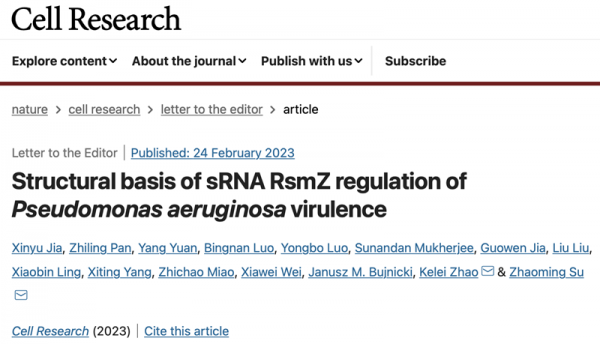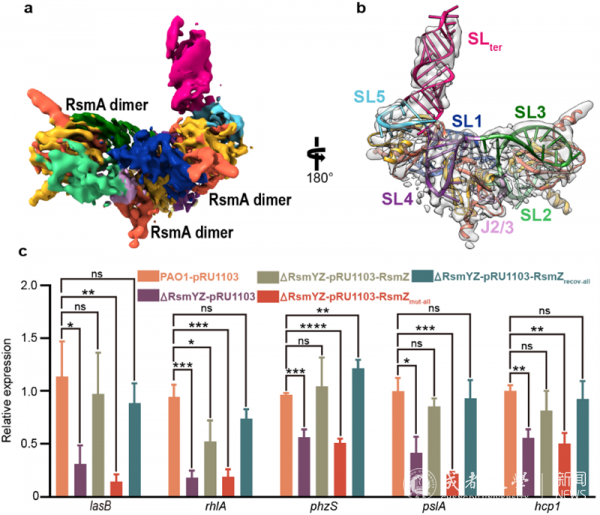The Research Fellow Zhao Kelei and his team at the School of Pharmacy Chengdu University (CDU) worked with the Research Fellow Su Zhaoming and his team from the State Key Laboratory of Biotherapy West China Hospital, Sichuan University to publish their latest research achievements in Cell Research (Q1 journal of Chinese Academy of Sciences, IF: 46.297), a top international journal. The paper jointly published by them is entitled Structural Basis of sRNA RsmZ Regulation of Pseudomonas Aeruginosa Virulence.

Pseudomonas aeruginosa is a gram-negative bacterium that is commonly seen in clinical medicine and has been identified as an opportunistic pathogen of both humans and plants. It causes acute or chronic respiratory tract infections in patients with pulmonary immune deficiency, including chronic obstructive pulmonary disease (COPD), cystic fibrosis (CF), and bronchiectasis. Pseudomonas aeruginosa is fatal with a high mortality rate. Due to its strong drug resistance, it is extremely hard to handle in clinical treatments. Although the existing structural and functional studies have shown that the homodimeric families of Rsm global regulatory proteins of Pseudomonas aeruginosa can be used to recognize GGA motifs of the sRNAs, the molecular insights into the full-length sRNA RsmZ architecture remain elusive, leading to the lack of understanding of RsmZ binding to RsmA and subsequent modulations of regulating pathogen virulence.

In their study, the two research teams adopted a structural basis of the full-length RsmZ binding to RsmA for the first time by single-particle cryo-electron microscopy (cryo-EM) and elucidated the molecular mechanism of Pseudomonas aeruginosa pathogenicity regulation. According to their results, RsmZ formed three bacterial repressing clamps through six stem loops comprising GGA motifs and meanwhile bound three RsmA proteins. With mutation and complementation tests, they found that complementary stem loops at the binding site were crucial to RsmZ binding to RsmA. Furthermore, they carried out RsmY/Z knockout and complemented wild-type and mutant strains to verify that RsmZ regulates virulence-related phenotypic characteristics and gene expressions such as biofilm formation, pyocyanin production, Type VI secretion system, and quorum sensing by forming complex three-dimensional structures with RsmA. Hence, their study prepares a structural biology basis for developing RNA-targeting drugs with sRNA RsmZ as novel RNA targets to handle multidrug-resistant (MDR) Pseudomonas aeruginosa.
Research Fellows Zhao from CDU and Su from Sichuan University are the corresponding authors of the paper. Yuan Yang (Yuan graduated with a master's degree in Microbiological and Biochemical Pharmacy from CDU), a Ph.D. student in a joint Ph.D. program offered by both CDU and Sichuan University is the first author of the paper. Their study has received strong support from the programs such as the National Natural Science Foundation of China (NSFC).
Cell Research, a flagship journal covering biology is sponsored by the Center for Excellence in Molecular Cell Science of the Chinese Academy of Sciences (CAS) and the Chinese Society for Cell Biology. It ranks 44th among 21,430 journals worldwide collated by Clarivate Analytics and takes first place in life sciences academic journals published in the Asia-Pacific region. It mainly comprises excellent research achievements related to cell biology and has a 2022 impact factor of 46.297.
Reference link: https://www.nature.com/articles/s41422-023-00786-3